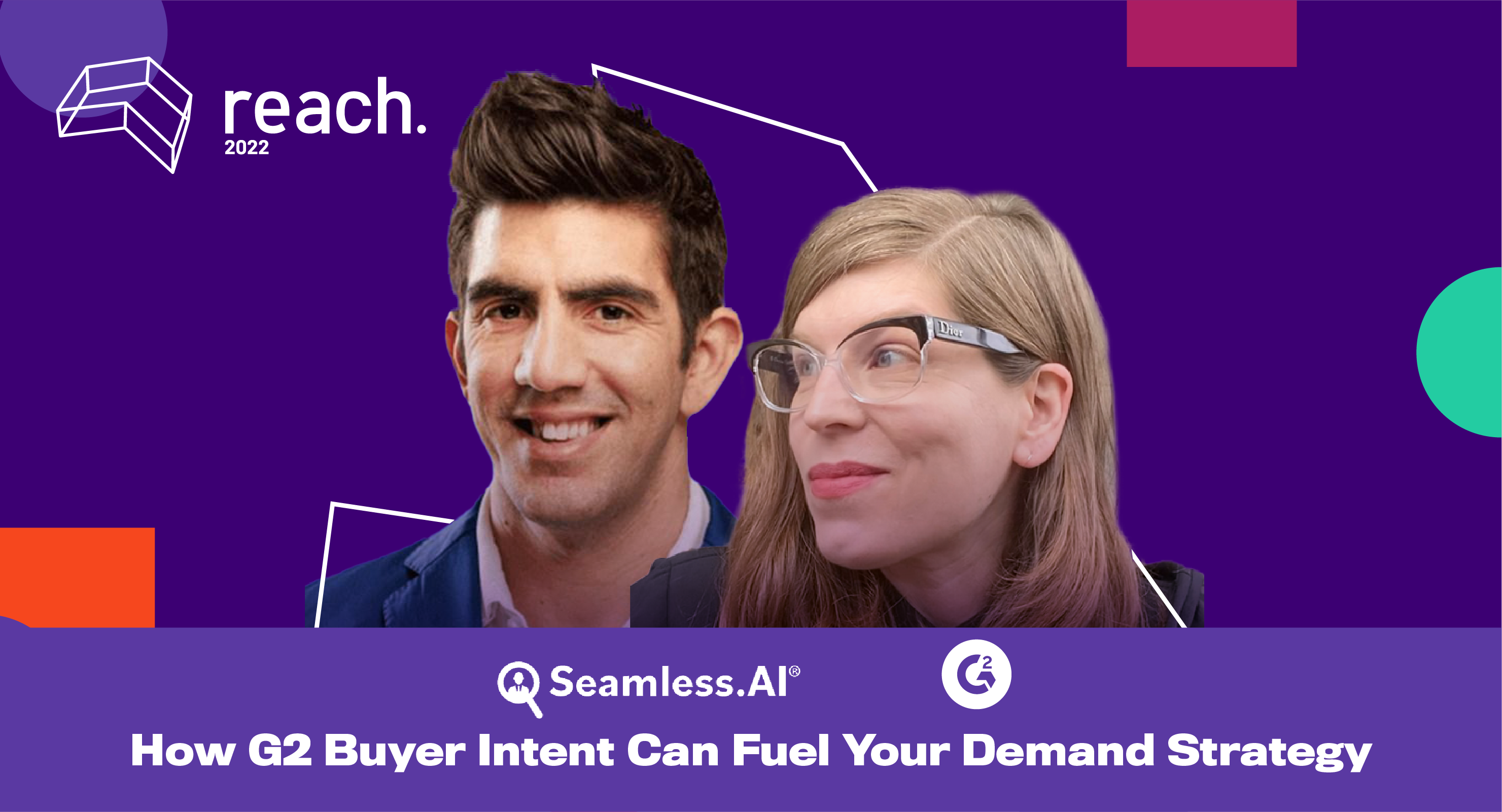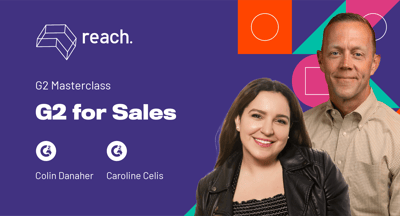February 14, 2024
 by Stephen Hoops / February 14, 2024
by Stephen Hoops / February 14, 2024

Marketers and sales teams are up for some challenging times ahead.
Between economic cooling and uncertainty in the tech world, organizations must be as lean and intentional as ever with their spending. Sales and marketing professionals must figure out how to do more with less.
Fortunately, intent data is an excellent solution for B2B software vendors to acquire and retain customers with pinpoint accuracy. It’s the difference between selling products to someone who’s only passively aware of your brand or is actively researching your solutions.
(I’m no sales pro, but I imagine you probably also prefer the latter).
There’s just one tiny problem: many organizations don’t know how to operationalize this data to maximize its value.
As part of Reach 2022, G2’s annual digital conference, attendees got to sit in on a masterclass presented by intent data experts Jonathan Pogact of Seamless.AI and Robin Iszak-Tseng. During the presentation, the two speakers shared some unique insights and learnings to help anyone make better use of their intent data.
If you couldn’t catch the masterclass during the live broadcast, don’t worry. We’ll break down some of the biggest takeaways right here.
It’s important first to grasp what intent data is and the different types of this data. Simply put, intent data is a set of signals or data points collected to indicate if someone is in the market to buy from you and where they are in the process.
Intent data can originate from many different sources. Where you source your intent data is how to distinguish between the three types:
Pertinent actions committed by G2 users power G2 Buyer Intent. Software vendors on G2 use Buyer Intent to identify specific behaviors of their target prospects and follow up with the appropriate action based on where a buyer is in the purchasing journey.
“No one comes to G2 for fun. People come to G2 to research, to find solutions to specific problems. Buyer Intent is a high intent match giving you insights into which specific companies are researching you.”
Jonathan Pogact
VP, Marketing, Seamless.AI
G2 Buyer Intent helps you see what companies are researching your business, which pages they’ve visited on G2, and which competitors they might be comparing you against.
That’s the kicker about Buyer Intent and why it can be a game changer for sales and marketing teams. Knowing what kind of research your prospective buyer is doing can be immensely helpful to nurturing a relationship and eventually closing deals.
Tip: If you currently have a free G2 Profile, you can still see up to two Buyer Intent prospects monthly at no cost in your my.G2 dashboard!
According to Pogact, intent data is largely misunderstood as a category. As intent data becomes more common, some questions and preconceived notions will persist. Let’s bust some myths that are untrue or lack the right context.
Anytime marketers get excited about new practices or innovative new technology, it’s easy to get swept up in the enthusiasm. The same is true about intent data, where a lot of marketers view it as some magic solution that will conjure up leads like crazy.
Pogact and Iszak-Tseng both agree that intent data is definitely powerful, but it’s not without its challenges.
“It's not quite magic. You have to operationalize it. You have to claim resources for it. You have to have a strategy, and it has to be intentional.”
Jonathan Pogact
VP, Marketing, Seamless.AI
Intent data can be an excellent solution and provide meaningful impacts throughout your customer journey. A crucial first step is to put a lot of thought into what it’ll take to put that data to good use.
Let’s go ahead and mark this one zero – because it’s flat-out wrong.
As mentioned earlier, there are three types of intent data. But let’s dig in a bit further.
The assumption is that all intent data is the same, no matter where you get it from. You could focus on getting intent data from a particular source, but you can paint a more precise picture of your prospective buyers when layering intent data from multiple sources.
“When you're pulling in signals from all over the web, it can be noisy. How you categorize, strategize, and follow up on that data is not the same. How you use it is quite different throughout the organization.”
Robin Izsak-Tseng
Former VP, Revenue Marketing, G2
When budgets get tight, and some less performance-oriented marketing activities get put on the chopping block, lead generation tends to be where many organizations shift their focus.
The good news is that intent data can create lead opportunities – it just depends on whether you can map the right strategies to the appropriate intent signal.
For example, say that Buyer Intent reveals a prospect that’s visited a competitor comparison page on G2. In this case, it would make the most sense to follow up with marketing content collateral or battle cards that easily demonstrate why your solution is a better fit for them.
In another scenario, let’s say your prospect has visited your G2 Profile and a relevant product category several times in the last few days. There’s a good chance that they’re more toward the beginning of their purchase journey, in which case you’d want to see if you can match the opportunity to any known contacts at that company.
TL;DR: You can most definitely use intent data to generate leads.
“You have to think of your intent data as part of your overall go-to-market. You're not always going to get the one call close from someone reviewing your profile.”
Jonathan Pogact
VP, Marketing, Seamless.AI
If you put all your sales, marketing, and customer success teams in a room and promise them more leads, better lead scoring, lower churn risk and more upsells, more meetings set and held, and better alignment overall, do you think anyone would object? Quite the opposite, you’ll probably have to make a case for how you intend to follow through on those promises.
Using G2 Buyer Intent data provides much value to more than just marketers. From sales to customer success, this intent data can provide insights into more than generating leads for software brands.
Sales and customer success teams crave gathering as much information as they can about prospects and customers. For example, let’s say your customer is researching a competitor’s feature set. Customer success can use this to go back to that customer to share documentation and tutorial content about a feature that they never even knew existed.
To get started, we recommend exploring which of your favorite tools can integrate with G2 Buyer Intent. For example, Pogact Jonathan raves about the G2 Buyer Intent + LinkedIn Sales Navigator integration, allowing you immediately identify prospects or personas in the app.
Intent data can be intimidating when you first set out. Amidst better alignment, more impactful marketing opportunities, and closing more deals, it’s crucial to get your strategy right. Using it to its fullest potential requires being more intentional.
Didn't get a chance to attend Reach? Check out the latest and complete on-demand recordings from Reach 2023 to get more unique insights and actionable tips SaaS industry experts.
Stephen Hoops is a former Sr. Content Marketing Specialist at G2. He focused on creating content that helps tech industry sales professionals and B2B SaaS marketers find success with G2 products such as Buyer Intent, Review Generation, and more. After receiving his B.A. in Journalism from West Virginia University in 2013, he has helped countless B2B brands reach new highs through content creation and SEO. When not nerding out about the artistry behind well-written copy, Stephen can be found info-dumping about homemade cocktails, Italian cuisine, and why vinyl is the superior physical medium for music.
As a demand gen marketer, I know first-hand how difficult it can be to deliver on ambitious...
 by Michael Pannone
by Michael Pannone
The disruption brought on by COVID-19 thrust marketers into a new reality and environment...
 by Kaitlyn Carpenter
by Kaitlyn Carpenter
G2 has long been a trusted tool by B2B marketers who have relied on the marketplace to source...
 by Colin Danaher
by Colin Danaher
As a demand gen marketer, I know first-hand how difficult it can be to deliver on ambitious...
 by Michael Pannone
by Michael Pannone
The disruption brought on by COVID-19 thrust marketers into a new reality and environment...
 by Kaitlyn Carpenter
by Kaitlyn Carpenter


